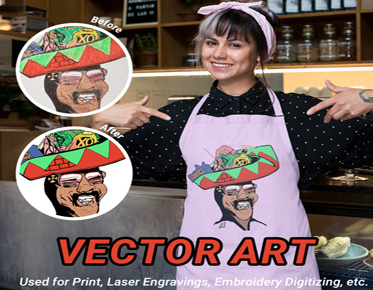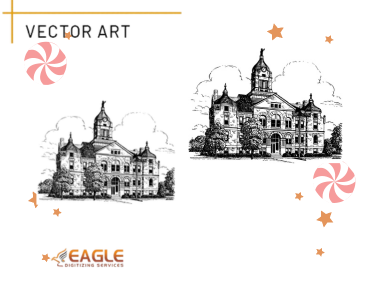Vector Art and the Pop Art Movement: A Visual Connection
The marriage of vector art and the Pop Art movement creates a visually compelling union that transcends time and cultural boundaries. Rooted in the vibrant expressions of popular culture, Pop Art emerged in the mid-20th century as a rebellion against traditional artistic norms. In this blog, we'll explore the symbiotic relationship between vector art and the Pop Art movement, delving into their shared principles, iconic elements, and enduring impact on contemporary visual culture. For the excellent online vector conversion in USA, have no qualms about getting in touch with us.
The Pop Art Revolution:
1. Origins and Rebellion:
The Pop Art movement, which flourished in the 1950s and 1960s, marked a radical departure from the abstract and expressionist art dominating the art scene. Originating in the United Kingdom and gaining momentum in the United States, Pop Art was a response to the commercialization of everyday life, mass media, and consumer culture. Artists sought to challenge the elitism of traditional art by embracing popular imagery and turning it into high art.
2. Bold Colors and Mass Reproduction:
Pop artists, such as Andy Warhol, Roy Lichtenstein, and Claes Oldenburg, embraced bold colors and mass reproduction techniques. They drew inspiration from advertising, comic books, consumer products, and celebrity culture. The use of vivid hues and the replication of images through techniques like screen printing echoed the mass-produced nature of the consumer goods celebrated in their art.
3. Iconic Subjects and Cultural Commentary:
Pop Art celebrated the mundane and transformed everyday objects and people into iconic subjects. Soup cans, soda bottles, comic book characters, and celebrities became recurring motifs. Through these familiar symbols, artists conveyed a poignant commentary on the commodification of culture, the allure of consumerism, and the impact of mass media on society.
Vector Art: Precision and Versatility:
1. Precision in Design:
Vector artwork, born in the digital age, is characterized by its use of mathematical equations to create clean, precise lines and shapes. Unlike raster images, vectors are resolution-independent, allowing for unlimited scalability without loss of quality. This precision aligns with the crisp lines and defined forms often seen in Pop Art compositions.
2. Versatility in Style and Imagery:
Vector art offers unparalleled versatility in style and imagery. Artists can seamlessly recreate the bold and graphic nature of Pop Art using vector graphics software. The adaptability of vector art allows for the exploration of various artistic styles while maintaining the boldness and clarity essential to the Pop Art aesthetic.
3. Efficiency in Reproduction:
Similar to the mass reproduction techniques embraced by Pop artists, vector art lends itself to efficient replication. Whether for digital displays, print media, or merchandise, vector images can be reproduced in various sizes without sacrificing quality. This efficiency aligns with the mass-production ethos that Pop Art both critiqued and celebrated.
Visual Connection: The Symbiosis of Vector Art and Pop Art:
1. Bold Colors and Vibrant Palettes:
One of the most striking connections between vector art and Pop Art lies in their shared love for bold colors and vibrant palettes. Pop Art's penchant for intense hues, often applied in flat, uniform tones, finds a parallel in the ability of vector art to create and replicate these striking color schemes. The result is visually arresting compositions that capture attention and convey a sense of energy.
2. Clean Lines and Defined Forms:
The clean lines and defined forms inherent in vector art seamlessly echo the aesthetic principles of Pop Art. From the precision of a Roy Lichtenstein comic strip-inspired piece to the iconic silhouettes of Andy Warhol's celebrity portraits, the marriage of vector art's precision with Pop Art's graphic boldness creates a visual synergy that enhances the impact of the artwork.
3. Iconic Symbols and Contemporary Imagery:
Both vector art and Pop Art share a fascination with iconic symbols and contemporary imagery. Vector artists can easily replicate and reinterpret the recognizable symbols of Pop Art, from Warhol's Campbell's Soup cans to Lichtenstein's comic book dots. This connection allows contemporary creators to pay homage to Pop Art while infusing their work with a modern twist.
4. Cultural Commentary and Satire:
Vector art, like Pop Art, provides a platform for cultural commentary and satire. Through the juxtaposition of familiar symbols, both artistic movements invite viewers to reflect on societal norms, consumer culture, and the impact of media. Vector art's adaptability makes it a powerful tool for contemporary artists to engage in conversations inspired by the Pop Art tradition.
Creating Vector Art in the Spirit of Pop:
1. Choose Bold and Striking Subjects:
When creating vector art in the spirit of Pop, choose bold and striking subjects that resonate with contemporary culture. Whether it's a reinterpretation of a classic Pop Art symbol or a fresh take on a modern icon, opt for subjects that command attention and evoke a strong emotional response.
2. Experiment with Vivid Color Schemes:
Embrace the vibrant color schemes synonymous with both vector art and Pop Art. Experiment with bold contrasts and dynamic combinations to create visually compelling compositions. The use of intense colors adds a layer of energy and immediacy to the artwork, capturing the bold spirit of Pop.
3. Integrate Pop Art Techniques:
Integrate Pop Art techniques into your vector creations. Experiment with the use of dots and lines to mimic the iconic Ben-Day dots popularized by Lichtenstein. Embrace the simplicity of forms and explore the visual impact of repetition and patterns, key elements in the Pop Art playbook.
4. Explore Cultural References:
Infuse your vector art with cultural references that resonate with the contemporary audience. Draw inspiration from current events, popular memes, or modern icons. This connection to the present ensures that your vector art not only pays homage to Pop Art but also engages with the ever-evolving cultural landscape.
The Contemporary Legacy:
The symbiotic relationship between vector art and the Pop Art movement continues to shape the visual landscape of contemporary art and design. As digital tools evolve, vector artists have the opportunity to carry forward the boldness, energy, and cultural critique embedded in Pop Art. The visual connection between these two movements serves as a dynamic bridge between the mid-20th century and the digital age, where creativity knows no bounds. For the premier online vector artwork conversion, feel free to connect with us.
Conclusion:
In the visual dance between vector art and the Pop Art movement, we witness a timeless connection that transcends artistic eras. The bold colors, clean lines, and cultural commentary shared by these two worlds create a visual synergy that captivates and challenges. As contemporary artists continue to draw inspiration from the rebellious spirit of Pop Art through the precision of vector graphics, they contribute to a legacy that celebrates the enduring power of art to reflect, critique, and shape the world around us. The journey continues, with each vector line and vibrant hue paying homage to the Pop Art ethos while pushing the boundaries of creative expression in the digital age.


.png)
